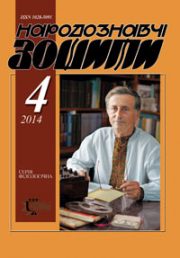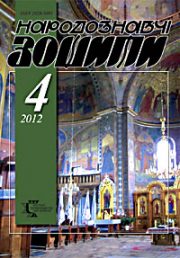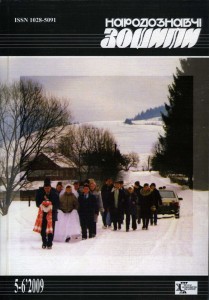2009 year, issue 5-6
Vovkanych Stepan. Economic Space in Integration Strategy of Ukraine Development: Theoretical-Methodological Aspect. P. 586-593
read »
Kyrchiv Roman. On Ethnocultural Borderland: Some Outlines of Object Fields On Ethnocultural Borderland: Some Outlines of Object Fields and Methodological Principles in the Studies of It. P. 594-607
read »
Lunyo Yevhen. On Polish Anti-Soviet Folklore Satire in Ukrainian Surrounding. P. 608-621
read »
Zabek Maciej. «Peoples in Exile». On the Role of Refugees’ Camps in Formation of Their Inhabitants’ New Identities. P. 622-633
read »
Hlushko Mykhailo. Ways of Communication And Traditional Transport in Stary Sambir Land. P. 634-648
read »
Gerus Ludmyla. On Kolach Ukrainian Ritual Bread and Peculiarities in Its Formative Treatment of Shapes. P. 649-661
read »
Ovcharenko Ludmyla. On Technologic Process of Domestic Pottery Production at Makariv Yar Village in Luhansk Region at the Late XIX to The First Half XX c. P. 662-684
read »
Movna Uliana. On World-viewing and Ritual Complex of Hutsuls’ Apiary Culture Meinhardt Iohannes Unsteady Abstraction. P. 673-684
read »
Romaniuk Volodymyr. Active Form of Traditional Hunting in the Ukrainian Carpathians in the Second Half of the 19th Century — the Middle of the 20th Century. P. 685-693
read »
Zhmurko Oksana. Coat-of-Arms: History of Formation and Place in Ukrainian Art. P. 694-698
read »
Hvozdevych Stefania. The Ukrainians of Carpathian Land and Turk Peoples of Crimea: A Comparative Analysis of Confinement Ceremonials. P. 699-702
read »
Mahdyuk Larysa. On Historical Aspects at Development of Feminine And Gender Movements in Independent Ukraine. P. 703-708
read »
Pakholok Inna. On Meteorological Theme in Polissians’. P. 709-713
read »
Sokil Hanna. On Editorial Textologic Concepts of Folcloristic Activities. P. 714-728
read »
Babiak Augustyn. On Part and Role of Catholic Chuch in Velehrad Congresses (1907-1936). P. 729-742
read »
Romanyshyn Marta. On Living in a Landscape. P. 743-747
read »
Sydor Mykhailo. Architectural Decorative Image of Galician Roadside Chapels: Means of Formation. P. 748-756
read »
Sokil Natalia. On Ethnocultural Aspect of Toponymes at Boiko Land by NTSh Ethnographical commission, Lviv. P. 757-763
read »
Kostyk Vasyl. On Bukovinian Folk Songs In Partenii Rusnak’s Notations. P. 764-771
read »
Bokalo Iryna. On Stereotypes in Behaviour of Ukrainian Youth (After Materials of Ukrainian Folk Songs on Loving). P. 772-778
read »
Belova Olga. On Self-Determination of Artist at 1920s: Creative Intention and Productive Self-Reflection. P. 779-782
read »
Hoshchytska Tetyana. On Choices of Constructive Material and a Place for Construction on Boiko-Highland Borderland. P. 783-791
read »
Semchuk Lesya. On Embroidery in Folk Clothes of Rozhniativ And Dolyna Regions. P. 792-800
read »
Sydoryk Tetyana. Caricature-Maker Pavlo Kovzhun’s Creative Figure Against the Background of Interrelations of Traditions and Western-European Artistic Influences in Development of Lviv Satirical Graphic Art at 1900s to 1930s. P. 801-805
read »
Shkolna Olha. On Ukrainian Porcelain from Suprematism to Post-Modernism: 1920s to 1990s – A Contemporary View. P. 806-810
read »
Cherevychna Marianna. On Kornylo Ustyyanovych’ Creative Work in the Context of Eastern European Culture. P. 811-816
read »
Pohorelchuk Volodymyr. Main Trends in Design of Lighting Appliance at Germany. (The Experiense by Designers of Zumtobel Firm). P. 817-819
read »
Yatsiv Roman. Volodymyr Lutsiv (In His 80th Birthday). P. 820-821
read »
Krasovsky Rostyslav. A Voice to Ukraine. P. 822-834
read »
Ivannikova Ludmyla. First Collection of Ukrainian Baptismal Songs. System of Wh. P. 835-837
read »
Hvozdevych Stefania. Neonila Zdoroveha (1.X.1931 — 20.XI.2009). P. 838-838
read »








